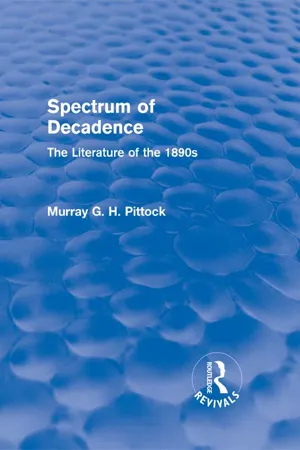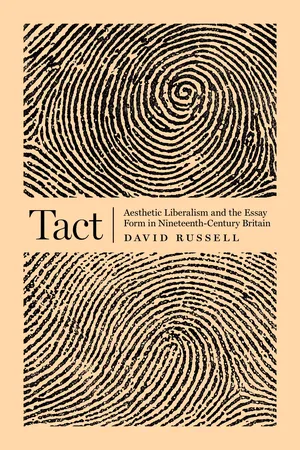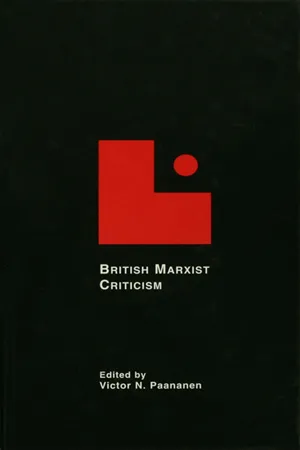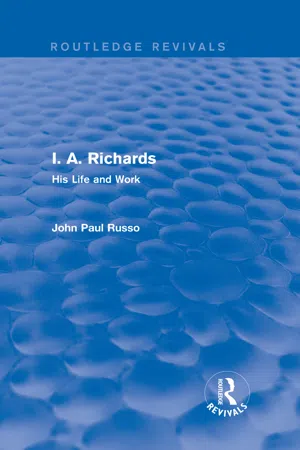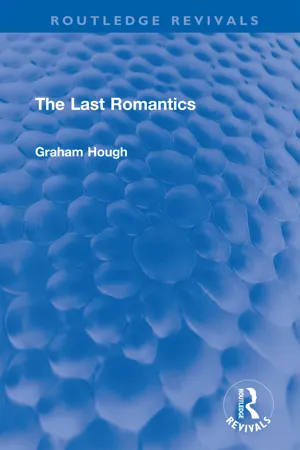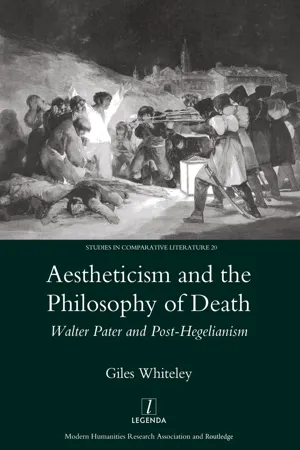Literature
Walter Pater
Walter Pater was an English essayist, critic, and writer known for his influential works on art and literature. He is particularly associated with the Aesthetic movement and his belief in the importance of experiencing life through art and beauty. Pater's writing often focused on the subjective experience and the idea of "art for art's sake."
Written by Perlego with AI-assistance
Related key terms
Related key terms
1 of 4
Related key terms
1 of 3
6 Key excerpts on "Walter Pater"
- eBook - ePub
Spectrum of Decadence (Routledge Revivals)
The Literature of the 1890s
- Murray Pittock(Author)
- 2014(Publication Date)
- Routledge(Publisher)
Chapter 1 Walter Pater and the French connection PATER’S ACHIEVEMENTOnly be sure it is passion – that it does yield you this fruit of a quickened, multiplied consciousness. Of such wisdom, the poetic passion, the desire of beauty, the love of art for its own sake, has most. For art comes to you proposing frankly to give nothing but the highest quality to your moments as they pass, and simply for those moments’ sake.(The Renaissance)The coffin was covered with beautiful wreaths.(The Times on Pater’s funeral)1It was Walter Pater, an Oxford academic, who in the late 1860s and early 1870s began to create in England the essential premises on which a native Symbolism would base many of its manifestations. In some respects his ideas were adapted from abroad, particularly from his knowledge of French literature: in others, he was powerfully drawn to classical and seventeenth-century English authors. Above all, in an age of progress and contemporaneity, where the premises of scientific action annihilated and reconstituted themselves in the course of a single generation, the generation of Darwin, Pater’s fascination with the past, the cores of human life and development, and the constant nature of human experience, provided implicit points of departure for those wishing to distance themselves from the collective and oppressive demands of ‘the social mill, that grinds our angles down’, and follow instead the ‘last curiosity’ of mortal human life, ultimately inexplicable in science’s terms.2The importance of Walter Pater’s thought lies in its subjectivity. Pater’s vision of the human condition is one which stresses the autonomy of the human spirit: that we create ourselves, and are the measure of our own value. Spiritual or moral absolutes are marginalized in Pater’s account of human experience, which substitutes for these beauty and passion as the ultimate expressions of life-affirmation in the face of death. In The Renaissance - eBook - ePub
Tact
Aesthetic Liberalism and the Essay Form in Nineteenth-Century Britain
- David Russell(Author)
- 2017(Publication Date)
- Princeton University Press(Publisher)
CHAPTER FIVE Relief Work Walter Pater’S TACTSelf-HelpWalter Pater wanted more from life. His essays raise the question of what this more might be, and where it might come from. They ask how we might become both more at home in and more penetrable by the vivid world. In an early essay, “Diaphaneitè” (1864), Pater rather mysteriously proposed: “He who is ever looking for the breaking of a light he knows not whence about him, notes with a strange heedfulness the faintest paleness in the sky.” All of Pater’s subjects seem engaged in this strangely heedful notation, as if on the lookout for a particular quality of life. “The service of philosophy, of speculative culture, towards the human spirit” says Pater, glossing a statement by Novalis, “is to rouse, to startle it to a life of constant and eager observation.”1 Pater’s writing speculates, as James Eli Adams has pointed out, at the boundary point of a “quickened sense of life.”2Pater’s style seeks not so much to impress as to seek the points where people become impressible by the world. These are shifting boundaries; to stay close to them, Pater’s writing eddies and flows, approaching and recoiling from its ostensible subjects in a way that often frustrated his critics. Instead of a destination, Pater offers us a rhythm. Against achieved narrative, Pater attends to the value of the present moment, in the space of a breath, and to the difference a moment can make (recurring themes are the metaphors of inspiration and expiration). The last words of his Renaissance claim that “art comes to you proposing frankly to give nothing but the highest quality to your moments as they pass, and simply for those moments’ sake” (RS, 190). Pater’s writing recurs to the moment’s quality, which teaches us—as for the ancient philosophers he echoed and queer theorists he anticipated—that the present alone is our happiness.3 His Renaissance is a curious work of history because it is not about what has happened, but what might - eBook - ePub
- Victor N. Paananen(Author)
- 2013(Publication Date)
- Routledge(Publisher)
Walter Pater
Alick WestAlick West, “Walter Pater,” pp. 111–23 of “Walter Pater and Oscar Wilde,” The Mountain in the Sunlight: Studies in Conflict and Unity (London: Lawrence and Wishart, 1958).I
‘Dear Pater was always afraid,’ Wilde is reported to have said, ‘of my propaganda.’ He was even a little afraid of his own. From the retirement of his classical fellowship at Brasenose College, Oxford, he published in 1873—he was born in 1839—a volume of essays entitled The Renaissance, of which Wilde said, ‘It is my golden book.’ Its ‘Conclusion’ contained a passage which, until the first world war, many an Oxford student could have repeated by heart. We all, he says, lie under sentence of death with indefinite reprieve:we have an interval, and then our place knows us no more. Some spend this interval in listlessness, some in high passions, the wisest in art and song. For our one chance is in expanding that interval, in getting as many pulsations as possible into the given time. High passions give one this quickened sense of life, ecstasy and sorrow of love, political or religious enthusiasm, or the ‘enthusiasm of humanity.’ Only, be sure it is passion, that it does yield you this fruit of a quickened, multiplied consciousness. Of this wisdom, the poetic passion, the desire of beauty, the love of art for art’s sake has most; for art comes to you professing frankly to give nothing but the highest quality to your moments as they pass, and simply for those moments’ sake.These ideas were frowned upon by the Oxford authorities as dangerous hedonism, and Pater was caricatured, in a style which anticipated the Punch cartoons of Wilde, by W. H. Mallock in The New Republic. In the next edition of The Renaissance Pater suppressed the ‘Conclusion’. But in subsequent editions he restored it; for though he was timid, he was also dogged.One must ask why Pater’s immoral gospel of art, as it was considered, should have provoked so much abuse. For in The Renaissance - eBook - ePub
I. A. Richards (Routledge Revivals)
His Life and Work
- John Paul Russo(Author)
- 2015(Publication Date)
- Routledge(Publisher)
60 Did such criticism represent anything more than an already mined-out doctrine, against which Richards campaigned in his first books? Nothing appears more distant from Benson's vague longings for the beautiful or Saintsbury and Quiller-Couch on the Grand Style than Richards' Benthamite utilitarianism, psychological models, and technical procedures for close reading, not to mention the intellectual rigor and professionalism that he exemplified. As Richards saw it, the situation required strong medicine. To escape the vagaries of aestheticism, he needed linguistics, neurophysiology, behaviorist psychology, and a micrological method of analysis, while also turning back to the more broadly based principles of the mid-Victorians and romantics.Although Richards' departure from aestheticism was radical, some connections between Pater (and Pater-inspired criticism) and Richards do hold. Most obviously, Richards shares Pater's relativism and pluralist approach to the beautiful, and both believe in the power of poetry to illuminate, to deepen, to guide consciousness up and down dangerous slopes. Pater's "quickened, multiplied consciousness" and ideal of the Renaissance personality have their counterpart in Richards' integrated consciousness and complementarity.61 With regard to psychology, Pater argued against abstract notions of beauty and did not investigate the process of reception; still, he focused on the process sufficiently to encourage others (e.g., Bullough) to do so. If Richards went much further in this direction, his analysis of stock responses and irrelevant associations has its parallel in Pater's attacks on routine and habit-clogged perception. The larger significance of theory is another matter and, according to Richard Wollheim, might depend on where one looks in Pater.62On the whole, though, Pater can hardly be said to have inspired the systematic spirit. He felt the poet Coleridge ran aground in his search for a philosophical Absolute, whereas Richards wrote one of his finest books on how Coleridge took up one theory after another to investigate the mind and the poem—which is a fair description of Richards' theory-soaked criticism. (Richards' harsh critique of Pater came in his defense of Coleridge's distinction between fancy and imagination, which he felt Pater to have obfuscated.)63 Richards championed theory and method. He knew that a rejection of theory must be founded, consciously or not, upon another theory; that "we shall in any case use theories"; that "good theories will protect us from worse"; and that theory and method are a training-ground in "careful and sometimes arduous thinking." At the same time, Richards never ceased warning against the limitations of theory, specifically against thinking that theory could substitute for that wholeness of mind in the judgment of significant poetry: the "more refined and discriminating our preconception of poetry is, the more impossible any direct application [of a theory] becomes."64 - eBook - ePub
- Graham Hough(Author)
- 2022(Publication Date)
- Routledge(Publisher)
Ch apter IV Walter Pater DOI: 10.4324/9780429032783-4 I. MARIUS THE LATITUDINARIAN B URNING with a hard gemlike flame has not been a popular practice in recent years; and we think of the aesthetes of the end of the last century, if we think of them at all, in terms of Yeats’s brilliant dismissal of the nineties in the introduction to the Oxford Book of Modern Verse ; or of Mr. Eliot’s essay on The Place of Pater. 1 This last. has the peculiarity of being largely about Matthew Arnold; but that is because its purpose is “to trace a direction from Arnold, through Pater, to the nineties, with, of course, the solitary figure of Newman in the background”. This may seem a somewhat arbitrary direction; but appearing in this way between Newman and the nineties, Pater and Arnold are sufficiently placed for Mr. Eliot’s attitude to become recognisable. His concern is with Pater as a moralist and writer on religious themes, and the most significant point about the essay is the close association of Pater with Arnold; or rather the reason given for this collocation—that they are members of a joint conspiracy whose object is to usurp the throne of religion and put culture in its place. Let us begin then by considering a little the position of the cultivated agnostic in Arnold's and Pater's day. Mr. Eliot begins by considering Culture and Anarxhy, and invites us to “raise an eyebrow to admire how much Culture has arrogated from Religion”; and he later suggests that Pater’s attitude merely provides an individual variant of the same process. If he had begun with the essay on The Study of Poetry it would have been necessary to raise the eyebrow higher still, for there Arnold is much franker about what he is doing. He says quite simply that since belief in religious dogma has decayed, values derived from imaginative literature must take its place. A process whose total effect, Mr - eBook - ePub
Aestheticism and the Philosophy of Death
Walter Pater and Post-Hegelianism
- Giles Whitely(Author)
- 2017(Publication Date)
- Routledge(Publisher)
By the end of Pater’s life, Oxford was generally deemed to have been Hegelianized, R. B. Haldane claiming in 1895 that ‘Oxford has been the cradle of a Hegelian movement’. 6 Pater’s project of aestheticism then was pursued in the same climate of philosophical enquiry at Oxford which fostered the idealisms of T. H. Green, Edward Caird, and William Wallace. 7 All three of these philosophers were, along with Pater, students of Benjamin Jowett (who himself did much to popularize Hegel in Britain), 8 and all three, again along with Pater, were members of Oxford’s Old Mortality Society. 9 Thus Pater’s reputation was initially founded on his comprehension of idealism and his aesthetic project ran concurrent with the philosophical movement of Oxford Hegelianism. But while the Hegelian inheritance underlying Pater’s thought has long been recognized, 10 what has not yet been shown is how Pater’s mature ‘reconsidered’ aestheticism relied, not on one or other of Hegel’s philosophies or doctrines, but on itself taking on Hegel’s structure and method to such a degree that Hegelianism became structural to Pater’s aestheticism. To repeat: the stakes of Pater’s Hegelianism cannot be deemed purely a question of influence. There is, of course, no question that Pater was influenced by Hegel, nor that Harold Bloom’s concept of the ‘anxiety of influence’ may productively be applied to Pater. Bloom himself has indeed done something similar with reference to Ruskin, arguing that whilst ‘Ruskin is ignored by name’ in Pater’s texts, ‘he hovers everywhere in them’. 11 But Pater’s response to Hegel is not merely to his texts, but takes the form of a total Hegelianization of his aestheticism
Index pages curate the most relevant extracts from our library of academic textbooks. They’ve been created using an in-house natural language model (NLM), each adding context and meaning to key research topics.
Explore more topic indexes
Explore more topic indexes
1 of 6
Explore more topic indexes
1 of 4
